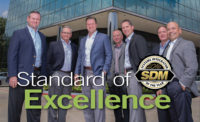SDM Systems Integrator of the Year 2009: Trusted Advisor


Milwaukee-based Johnson Controls got its start in the building controls industry 125 years ago. (See related story, “Founded in 1885”) It wasn’t until the late 1990s that it formally entered the security industry through its acquisition of access control giant Cardkey. Security and fire safety solutions today are delivered through Johnson Controls’ Building Efficiency business. But until this year, those solutions were routinely delivered through a “siloed” approach to the market; the firm knew it could more successfully address its customers’ business needs by integrating services across the various disciplines within Building Efficiency. Those services are comprehensive enough to allow it to function as a single-source provider. They include risk identification, systems assessment, scope development, project management, technology and contractor partnerships, systems configuration, user training, labor and materials, PSA, implementation of new technology and remote monitoring.

SERVICE DELIVERY RESOURCES
Many processes, practices and resources go into that delivery aspect. For example, Johnson Controls uses an approach called Johnson Controls Technology Contracting.™ “It involves assigning a single point of responsibility upfront to bring an enterprise-wide perspective to managing the planning, design, installation, integration, commissioning and service of low-voltage systems, business applications and supporting infrastructure,” Roy explains.
“Technology contracting can save time, reduce risk and decrease construction and operating costs while ensuring that technology is deployed and integrated in an orderly manner to achieve desired outcomes. Technology contracting helps building technology fulfill its promise – and helps building owners to realize their vision,” she says.
The plan for the future, Roy states, is to continue to build on the market competence Johnson Controls has already established worldwide in the building controls business.

Johnson Controls At a Glance
Headquarters: Milwaukee, Wis.
Traded on the New York Stock Exchange under ticker symbol JCI
Fiscal year 2008 revenue: $38.1 billion
Employees: Approximately 140,000 worldwide; 2,500 in Milwaukee
Locations: More than 1,300 worldwide
Ranked on SDM’s Top Systems Integrators Report: No. 6
Johnson Controls has three business units:
Automotive Experience – Automotive interiors that help make driving more comfortable, safe and enjoyable
FY2008 revenues: $18.1 billion
75,000 employees
Building Efficiency – Products and services that optimize energy use; improve comfort, security for buildings
FY2008 revenues: $14.1 billion
54,000 employees
Power Solutions – Batteries for automobiles, hybrid electric vehicles<p>
FY2008 revenues: $5.9 billion
12,000 employees
Multi-Decade Project Relies on Continuity in Technology
Camana Bay was conceived as a series of four linked villages, with a resort on the west edge linking to the Town Centre and then on to residential areas and a marina village on the eastern edge of a 238-acre plot of land, which has doubled to accommodate more residential area. Camana Bay is a walkable community with a mix of housing, shops, restaurants, civic space, parks and a school.
Beginning with the end in mind
Johnson Controls’ Management Team
Lisa Roy, vice president, Global Security & Fire... 15
Joel Lehman, vice president, North America Security & Fire... 20
John Fenske, director, Global Security Alliances & Support... 10
Development & Engineering... 18
Jay Alix, director, Global Account Sales... 15
Founded in 1885
Johnson Controls continued to develop innovative new control technologies to help customers better manage their increasingly larger and more complex buildings. In 1972, Johnson Controls built the industry’s first mini-computer dedicated to building control – the JC80. Today, its Metasys® Facilities Management System is reducing energy costs and improving indoor comfort in thousands of buildings around the world.
In 1998 Johnson Controls acquired Cardkey, a major provider of access control and security systems — marking its entrance into the physical security space. — Adapted from “A History of Exceeding Expectations,” as published at www.johnsoncontrols.com
Technology Expo
Johnson Controls bases this precept on four “pillars”: ID management, event management, compliance management and building management.
Although Johnson Controls set up the technology expo as a temporary exhibit, the company would like to find space to make it permanent. The exhibit consists of seven “scenarios” that visitors can explore in a circuitous route, crowned in the middle by a Microsoft SurfaceTM tabletop computing demonstration. Around the perimeter of the circular space, exhibits demonstrate how an integrated solution can work best to help an end user achieve the most value by, again, minimizing risk, reducing cost and meeting compliance.
“You can have access, you can have surveillance, you can have fire alarm and you can have BMS (building management systems), but if you don’t have them fully integrated as a complete solution, focused on your customer’s business needs, you miss a great opportunity to add value to your customer,” Costa emphasizes.
The Microsoft Surface computing table drew much attention, as Costa and Scott Herman, engineering manager, User Experience, demonstrated this unique new technology with which users can control and interact with their facilities in a very natural way.
“We need to integrate with past, present and future technologies — it’s not enough to simply integrate,” Costa says.
Looking for a reprint of this article?
From high-res PDFs to custom plaques, order your copy today!






